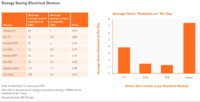Please can someone explain how to read the data in the attached photo?
I know how to find averages I am just so confused with this table. The questions are below, any help would be much appreciated!
1. What is the average annual energy saving from using Eco DVD model compared to the standard model based only on the time they are switched on? Please give your answer to one decimal place.
2. Assuming average usage, what is the total annual energy usage for the standard PVR model assuming it is left in standby mode when it is not switched on?
3. Assuming average usage, what is the difference in total average energy usage between the Standard Heater and the Eco Heater over 3 years assuming both models are left in standby mode when not switched on?

I know how to find averages I am just so confused with this table. The questions are below, any help would be much appreciated!
1. What is the average annual energy saving from using Eco DVD model compared to the standard model based only on the time they are switched on? Please give your answer to one decimal place.
2. Assuming average usage, what is the total annual energy usage for the standard PVR model assuming it is left in standby mode when it is not switched on?
3. Assuming average usage, what is the difference in total average energy usage between the Standard Heater and the Eco Heater over 3 years assuming both models are left in standby mode when not switched on?

